Today I want to share a Japanese garlic fried rice recipe that I learned from a restaurant chef.
If you are looking for an easy and tasty meal, you are in the right place. Simple ingredients, quick and easy cooking technique, and delicious upon delicious.
According to my chef friend, the secret of preparing Japanese garlic fried rice is the perfect timing and temperature to fry the garlic.
Let me get into the details right in.
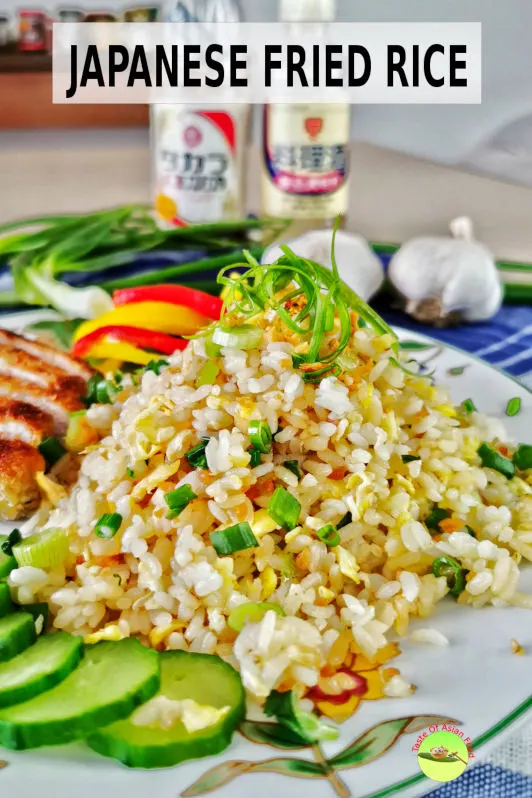
Note: This post may contain affiliate links. Please read my privacy policy for more info. I may receive commissions for purchases made through links in this post. As an Amazon Associate, I earn from qualifying purchases.
How to make Japanese fried rice
Note: I learned how to prepare Japanese garlic fried rice from a chef working in a Japanese restaurant and decided to use the Chinese wok and high-power stove to generate the wok aroma, a typical Chinese method. As a result, it is not exactly the way he does it with the teppan. Therefore, I do not claim this is authentic Japanese fried rice, but I improvise it based on his method.
1. Fried the garlic to perfection
Crispy garlic is the secret ingredient of the best Japanese garlic fried rice. You need to fry the garlic separately from the rice before mixing them.
This is the most crucial step of this recipe. The purpose is to fry the garlic, either chopped or thinly sliced, in shallow oil until crispy and golden.
Saute the garlic over low heat is the key, as high heat will brown the garlic’s surface before the internal gets dry, resulting in the garlic that is brown but not crispy.
When done correctly, the garlic is golden and crispy, and the oil infused with the garlic’s flavor and aroma will be used to fry the rice.
You may not need all the oil to fry the rice. The excess oil can be kept for other stir-fried dishes.
In summary, here are the steps to fry the garlic:
- Thinly sliced or finely chopped garlic. (Your choice).
- Add enough oil to submerge all the garlic in a pan.
- Gently heat the oil in a pan.
- Add the garlic chips and fry over medium-low heat. Keep the temperature low to keep the oil bubbling slowly around the garlic with a soft sizzling sound.
- It is important to stir continuously to ensure even browning.
- After a few minutes, the garlic will dry up and become stickier. It may clump together and stick to the spatula /fork you use. Break up any garlic that sticks together for even browning.
- When the garlic starts changing to a golden brown, reduce the heat further, as it will darken quickly. Pay attention now because it can burn rapidly and taste bitter. Stir frequently, and close observation is critical.
- When the garlic falls slightly short of golden, pour the garlic and oil through a wire mesh strainer. If you remove the garlic from heat when it reaches the desired color, it will continue darkening when you pour and drain it, and the final result will be darker than expected.
- Let the garlic drain in the strainer, and use the garlic oil to fry the egg and rice in the next step.
2 How to prepare Japanese garlic fried rice
Assuming you have cooked the rice in advance, you can now start to fry the rice.
Here are the detailed steps to fry the rice.
- Heat a large ladle of garlic oil (from frying the garlic) in the wok. Swirl the oil to coat the entire wok surface. Remove the excess oil.
- Pour two beaten eggs into the wok over medium heat.
- Swirl the wok around to thin out the egg liquid. When the egg starts to thicken, break it up the egg into pieces with the spatula.
- Pour the cooked rice into the wok while the eggs are not fully solidified. Part of the egg will coat the rice grains, while the other half will turn into bright yellow pieces of cooked eggs.
- Continue stir-frying the egg and the rice and break up any lumps of rice with the wok spatula. This step will separate all the rice grains and enable them to be coated by the oil, resulting in fried rice that is free-flowing and not lumpy.
- Now season with salt, light soy sauce, mirin, and sake. You can also include sesame oil and ground black pepper if you prefer.
- Return the fried garlic to the wok when the rice is getting dryer. You can also add the chopped scallion now.
- Turn to high heat and stir-fry swiftly and keep flipping the rice so that each grain will contact the hot surface in a split second. High heat is the secret to getting the wok aroma. Quick stir-fry can prevent the rice from getting burned. The chef will achieve it by tossing the wok quickly, but flipping with the wok spatula will yield the same result.
- The high-heat stir-frying should be within half to one minute. The rice will become dry inside if you keep stir-frying at this temperature.
- Once done, remove the rice immediately from the wok to prevent it from getting burnt. The wok aroma is most apparent when the Japanese garlic fried rice is served immediately.
Tips to prevent the rice from sticking during stir-frying
I use Japanese rice in this recipe. You can substitute it with long grain rice (Jasmine rice), but the mouthfeel differs slightly. Japanese short grain rice is chewier and springier, unique to Japanese fried rice.
One of the familiar problems of making fried rice is it tends to stick to the wok. Here are my tips for cooking the rice to prevent it from sticking to the wok/pan while frying.
1. Use old rice to fry
- Use leftover rice. This method is proven since the rice’s surface will dry out after exposure for a long period.
- Blow the rice under the fan. Sometimes we have to use fresh rice to fry when we run out of overnight rice in the restaurant. Spread the newly cooked rice thinly on a large baking tray and blow it under the fan for 20 minutes will do the trick.
2. Wash the rice multiple times
My next trick to make the rice less sticky is to wash it by changing the water at least five times or until the water runs clear before boiling the rice
This step effectively removes the surface starch that causes the rice to clump together or get gummy as it fries.
You will get fried rice, and each grain is separated from the other.
3. Season the wok (an important step)
A well season wok is indispensable to produce the best quality fried rice. The rice will still stick to the wok while frying with high heat if it is not well seasoned and fails to generate wok-hei.
Please refer to the embedded video in this article, which shows that the wok is still glossy and shining after the rice is removed. Also, I removed the excess oil in the wok before frying. If it is well seasoned, you don’t need plenty of oil to fry rice. It behaves like a non-stick frying pan.
4. Never add water to the fried rice
A misconception to prevent the rice from sticking to the wok is to add water during stir-frying. It sounds logical but is counterintuitive because once the water dries up, it becomes more sticky as the rice becomes gummy. Besides, you can’t generate the wok aroma if the rice is wet.
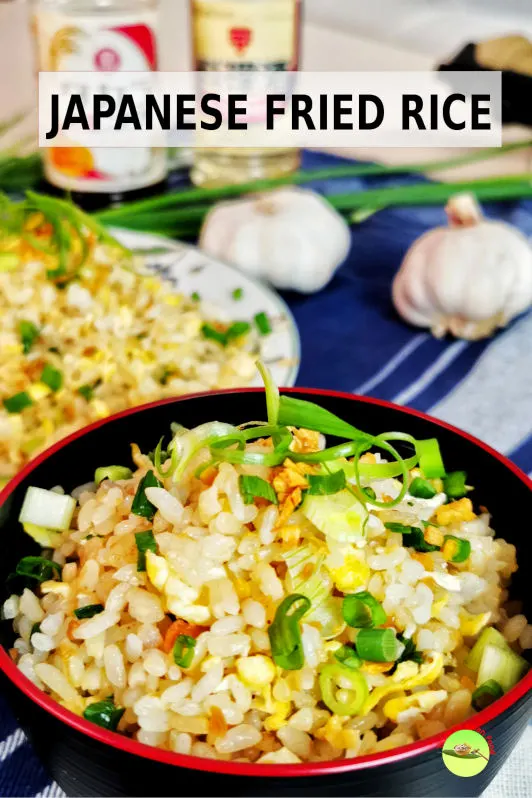
More tips to prepare the best fried rice
1. Do not use butter in this garlic fried rice recipe
Butter and olive oil are unsuitable in this recipe because I use high heat to fry the rice. The butter’s smoking point is 150°C/300°F, way below the heat generated by the high-power gas stove. The surface temperature can reach up to 315°C/600°F, so even constant quick tossing will not prevent the butter from breaking down. Therefore, oils with high smoking points, such as corn, peanut, and palm, should be used.
You need to fry the rice over lower heat to prevent the butter from turning into smoke. Doing so will give you the butter flavor (not the authentic Japanese), but you must forego the wok aroma.
2. Does it always require high heat to fry rice?
There is no need to use high heat at the beginning. Start frying the rice over low heat, then gradually increase over time. The rice sticks to the wok if you start with a high temperature. After a while, it gets dryer and coated with the oil. Now, gradually increase the heat, and turn to high heat at the final stage to create the wok aroma.
3. How to make Japanese garlic fried rice without the wok
You do not necessarily need a wok to fry the rice, although the result is superior. The Japanese chef is always stir-frying the rice on the teppan (the giant steel griddle at the teppanyaki counter), which works pretty much the same as the wok.
Cook with an electric or induction stove
What if you do not own a high-power stove like me? The high-power gas stove is popular in Asia. It only cost me RM70/USD17.50. It can generate roaring heat and turn it down to simmer or slow cook. I have a small family, and that is the all-purpose stove in my kitchen.
However, the high-power gas stove may not be available if you are living outside of Asia. When visiting my son in New Zealand during the last Chinese New Year, I used his electric stove to fry rice with a large pan. The wok aroma wasn’t as strong as my trusted gas stove and cast iron wok, but the result should be gladly accepted if served at any restaurant.
Here is the method to fry rice with an electric stove.
- Use a large skillet with a flat-bottomed and with a high edge. It helps to prevent the morsel of food from falling out when you stir-fry.
- Stir-fry in small batches, preferably one large serving each time. The heat generated by the electric stove is insufficient to sustain the high heat for a considerable amount of rice to produce the
- wok aroma.
- Break the stir-frying process into two. The first step is to fry the eggs, rice, fried garlic, scallion (green onions, spring onions), and seasonings. It is the same as using a wok. After that, remove the rice from the pan.
- Now put the empty pan on the stove and wait until it becomes very hot.
- Return one portion of the half-done fried rice to the pan. Stir-fry the rice quickly at maximum stove power. The heat from the pan will immediately transfer to the rice, effectively generating the wok aroma.
4. Use Japanese seasonings: Shoyu, mirin, and sake
I use Japanese soy sauce, mirin, and sake apart from salt for the fried rice. You can add some ground pepper and sesame oil if you like.
I prefer using the Japanese light soy sauce (usukuchi) because the dark soy sauce makes the color of the fried rice less attractive.
Note: Mirin and sake contain alcohol. Omit them from the recipe if you are non-alcoholic.
Other related recipes
If you like this Japanese garlic fried rice recipe, you may also want to try the following related recipes.
Fried rice with Chinese sausage. Chinese sausage fried rice 臘腸炒飯 is an ideal dish for a quick meal. This dish is also a welcome respite from elaborate cuisine and binge eating during the Chinese New Year.
Gyōza is a smaller dumpling encased with finely minced meat and cabbage. You may eat it fresh from the pan or dunk it into a sauce comprised of soy sauce, vinegar, and chili oil for extra flavor.
Miso soup 味噌汁 is a warm and comforting Japanese soup prepared with a soup stock (Dashi) and miso paste. It is the Japanese’s soul food, which serves together with rice.
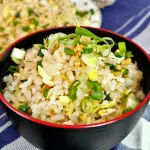
Japanese fried rice with garlic
I want to share a Japanese fried rice recipe.
If you are looking for an easy and tasty meal, you are in the right place.
Simple ingredients, quick and easy cooking technique, and is delicious upon delicious.
The secret of preparing Japanese garlic fried rice is the perfect timing and temperature to fry the garlic.
Ingredients
- 450g cooked rice, cooked a day ahead with 160g dry short-grain rice
- 5 cloves garlic, coarsely chopped
- 2 tbsp vegetable oil
- 2 large eggs, beaten
- 1 large stalk of scallion, cut into small rings
- 1/2 tsp salt
- 1 tsp Japanese soy sauce
- 1 tsp mirin
- 1 tsp sake
- Sesame oil and ground pepper (optional)
Instructions
Fry the garlic:
- Add enough oil to submerge all the garlic in a pan.
- Fry the garlic over low heat. Stir continuously to ensure even browning.
- When the garlic becomes slightly fall short of golden, pour the garlic and oil through a wire mesh strainer.
Fry the rice:
- Heat a large ladle of garlic oil (from frying the garlic) in the wok.
- Pour two beaten eggs into the wok over medium heat. When the egg starts to thicken, break up the egg into pieces with the spatula.
- Pour the cooked rice into the wok while the eggs are not yet fully solidified. Break up any lumps of rice with the wok spatula.
- Season the rice with salt, light soy sauce, mirin, and sake.
- When the rice is getting dryer, add the fried garlic and scallion.
- Stir-fry the rice over high heat for half a minute.
- Remove the rice immediately and serve.
Recommended Products
As an Amazon Associate and member of other affiliate programs, I earn from qualifying purchases.
-
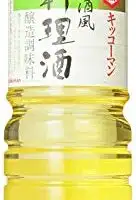 Kikkoman Ryorishi Cooking Sake Seasoning, 33.8-Ounce (Pack of 3)
Kikkoman Ryorishi Cooking Sake Seasoning, 33.8-Ounce (Pack of 3) -
 Kishibori Shoyu (Pure Artisan Soy Sauce), Premium Imported Soy, unadulterated and without preservatives, 12.2 fl oz / 360ml
Kishibori Shoyu (Pure Artisan Soy Sauce), Premium Imported Soy, unadulterated and without preservatives, 12.2 fl oz / 360ml -
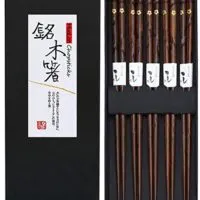 HuaLan Japanese Natural Wood Chopstick Set Reusable Classic Style Chopsticks 5 Pairs Gift Set
HuaLan Japanese Natural Wood Chopstick Set Reusable Classic Style Chopsticks 5 Pairs Gift Set -
 Nishiki Premium Sushi Rice, 10lbs
Nishiki Premium Sushi Rice, 10lbs
Nutrition Information:
Yield: 2 Serving Size: 1Amount Per Serving: Calories: 385Total Fat: 26gSaturated Fat: 4gTrans Fat: 0gUnsaturated Fat: 20gCholesterol: 186mgSodium: 802mgCarbohydrates: 28gFiber: 1gSugar: 2gProtein: 10g
This data was provided and calculated by Nutritionix on 12/29/2020

Salted Egg Fried Rice - How to make it at home
Saturday 28th of June 2025
[…] Japanese-style garlic fried rice […]
Cashew Shrimp Recipe (腰果蝦仁) - Quick & Easy Chinese Stir-fry
Wednesday 10th of July 2024
[…] Garlic fried rice is one of my favorites. (White rice also pairs well with cashew shrimp) […]
Shrimp and eggs recipe (Cantonese style)- 滑蛋虾仁
Saturday 6th of July 2024
[…] Garlic Fried Rice: A flavorful and easy-to-make fried rice recipe. […]
Cathy Santyr
Wednesday 30th of December 2020
I just have a regular electric burner cooktop. Is there any point in buying a wok as the burner may not ever get hot enough?
KP Kwan
Wednesday 30th of December 2020
Most of the electric burners do not generate sufficient heat to fry a large batch of rice. I suggest you use a large skillet or pan, and fry in small batches. Fry as mentioned in the recipe until adding the scallion. Then remove the rice from the pan. Heat the empty pan until very hot, then return the rice to the pan to create the wok aroma.
Elise
Wednesday 30th of December 2020
Hi, if I make the rice the day before, do I put it in the refrigerator overnight? If so, do I need to let it come to room temperature before frying it or can I dump it into the wok straight from the refrigerator?
KP Kwan
Wednesday 30th of December 2020
I suggest keeping the rice in the refrigerator for freshness. However, cold rice tends to be more sticky, so it is better to wait until it is back at room temperature (or microwave) to soften it before stir-frying.